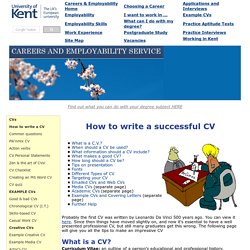

BICYCLE. Adecco - How To Write The Perfect CV. An effective CV will showcase your most relevant skills and experiences, whilst telling a prospective employer why you are right for the job.

Follow the simple steps laid out in this guide and you’ll be well on your way to achieving the perfect CV. Put yourself in the employer’s shoes Before you apply for any role you need to gain an understanding of the type of person the prospective employer is looking for. Whether it’s from a job advert, person specification or conversation with the company itself, use this information as a blue-print for your CV. The more effectively you show a clear match between the skills required and those you possess, the more likely you are to secure an interview. Be honest and factual Your CV will typically be used to structure the interview and could be the foundation on which the job is built, so providing inaccurate information will only lead to problems further down the line.
Make yourself easy to contact It seems obvious but not everybody does it. Layout. How to write a successful CV. Probably the first CV was written by Leonardo Da Vinci 500 years ago.

You can view it here. Since then things have moved slightly on, and now it's essential to have a well presented professional CV, but still many graduates get this wrong. The following page will give you all the tips to make an impressive CV What is a CV? Curriculum Vitae: an outline of a person's educational and professional history, usually prepared for job applications (L, lit.: the course of one's life). A CV is the most flexible and convenient way to make applications. An application form is designed to bring out the essential information and personal qualities that the employer requires and does not allow you to gloss over your weaker points as a CV does. There is no "one best way" to construct a CV; it is your document and can be structured as you wish within the basic framework below.
When should a CV be used? When an employer asks for applications to be received in this format. Personal details Work experience. How to write a successful CV before applying for a job. 11 January 2015Last updated at 19:12 ET By Kevin Peachey Personal finance reporter, BBC News Kevin Peachey reports on the advice available for getting a potential employer's attention Employers receive an average of 60 applicants for every advertisement for a low-skilled job, and 20 for every skilled job.

Significantly, almost half of these candidates are perfectly suitable for the role, according to research by the Chartered Institute of Personnel and Development (CIPD) So that makes their CV - or curriculum vitae - all the more important when attempting to stand out from the crowd. Experts say there are some golden rules for getting a CV correct, not least accuracy, spelling and grammar. Don't repeat the mistakes, they say, of a lawyer who stressed his "dew diligence", or the applicant who ignored commas when describing his interests as "cooking dogs and interesting people". Key points. A Guide To Create The Perfect CV. Your CV should be a living, breathing, growing document.

By that, we don’t mean it should leave the confines of your desktop, spring into life, and make your morning cuppa (that would be weird. Good, but weird), but it should grow and evolve as you do. And even if you don’t have any new roles or skills to add to it, you’ll more than likely need to adapt it to specific jobs, sectors and companies. Employers don’t have time to read between the lines, so the more you do to show how great you are for the job you’re trying to bag, the more chance you’ll have of getting it. Remember, the reader will be asking themselves two very basic questions: Can you do the job? Make sure the answer to both of these questions is ‘yes’ by: Moulding your CV to match what they’re looking for Making it clear where your skills meet their needs Pointing out the value you could bring to their organisation Mind your language Proof read Layout Structure Personal information Personal statement Work experience.